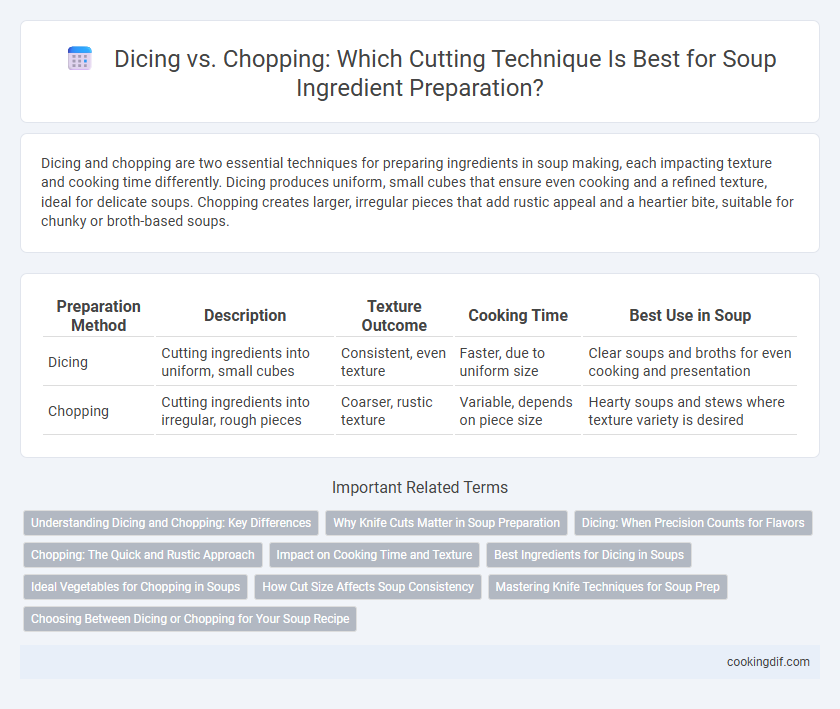Dicing and chopping are two essential techniques for preparing ingredients in soup making, each impacting texture and cooking time differently. Dicing produces uniform, small cubes that ensure even cooking and a refined texture, ideal for delicate soups. Chopping creates larger, irregular pieces that add rustic appeal and a heartier bite, suitable for chunky or broth-based soups.
Table of Comparison
| Preparation Method | Description | Texture Outcome | Cooking Time | Best Use in Soup |
|---|---|---|---|---|
| Dicing | Cutting ingredients into uniform, small cubes | Consistent, even texture | Faster, due to uniform size | Clear soups and broths for even cooking and presentation |
| Chopping | Cutting ingredients into irregular, rough pieces | Coarser, rustic texture | Variable, depends on piece size | Hearty soups and stews where texture variety is desired |
Understanding Dicing and Chopping: Key Differences
Dicing and chopping are essential cutting techniques in soup preparation that influence texture and cooking time. Dicing produces uniform, small cubes that ensure even cooking and a refined presentation, while chopping results in irregular pieces, offering a rustic texture and quicker cooking. Mastering the difference between dicing and chopping helps achieve the desired consistency and enhances the overall flavor balance in soups.
Why Knife Cuts Matter in Soup Preparation
Precise knife cuts in soup preparation influence cooking time, texture, and flavor release by ensuring even heat distribution and uniform ingredient sizes. Dicing creates small, consistent pieces that cook quickly and blend smoothly into the broth, enhancing mouthfeel. Chopping yields larger, irregular pieces that provide varied texture and more pronounced individual flavors within the soup.
Dicing: When Precision Counts for Flavors
Dicing ingredients for soup ensures uniform cooking and balanced flavor distribution, as evenly cut pieces release their taste consistently throughout the dish. Precision in dicing enhances texture and presentation, making each spoonful appealing and harmonious. Fine dicing is especially crucial for delicate vegetables like onions and carrots, which meld seamlessly without overpowering the soup's overall flavor profile.
Chopping: The Quick and Rustic Approach
Chopping ingredients for soup ensures a quick, rustic texture that enhances the dish's hearty character. Larger, uneven pieces retain more natural moisture and provide a satisfying bite, perfect for chunky vegetable soups or stews. This method reduces prep time without sacrificing flavor, making it ideal for casual, comforting meals.
Impact on Cooking Time and Texture
Dicing ingredients into uniform small cubes ensures even cooking and a consistent texture in soups, reducing overall cooking time by allowing heat to penetrate more quickly. Chopping produces irregular, larger pieces that may require longer simmering for tenderness, which can result in varied textures within the same dish. Precise dicing promotes a smoother, more homogenous mouthfeel, while chopping contributes to a heartier, rustic texture in the final soup.
Best Ingredients for Dicing in Soups
Dicing ingredients like carrots, celery, and onions ensures even cooking and consistent texture in soups, enhancing flavor integration. Uniform small cubes maximize surface area, allowing these vegetables to release their natural sweetness and aromas during simmering. Choosing firm, fresh produce for dicing maintains integrity and prevents mushiness in the final dish.
Ideal Vegetables for Chopping in Soups
Chopping is ideal for hearty vegetables like carrots, celery, and potatoes that add texture and substance to soups. Larger, uneven pieces retain their shape during simmering, enhancing the visual appeal and mouthfeel in rustic or chunky soup styles. These vegetables release flavor gradually, contributing to a rich, well-balanced broth throughout cooking.
How Cut Size Affects Soup Consistency
Dicing ingredients for soup creates uniform, small pieces that cook evenly, resulting in a smooth and consistent texture. Chopping produces larger, irregular pieces that add varied texture and a heartier feel to the soup. The cut size directly impacts cooking time and the overall mouthfeel, influencing how flavors meld and the soup's final consistency.
Mastering Knife Techniques for Soup Prep
Mastering knife techniques for soup prep involves understanding the difference between dicing and chopping ingredients to achieve desired texture and cooking times. Dicing creates uniform, small cubes ideal for evenly cooking vegetables like carrots and onions in clear broth soups. Chopping provides irregular, larger pieces suitable for rustic soups or stews where varied texture enhances flavor complexity.
Choosing Between Dicing or Chopping for Your Soup Recipe
Choosing between dicing and chopping for your soup recipe depends on the desired texture and cooking time; diced vegetables create a uniform, tender consistency perfect for smooth soups, while chopped pieces provide a heartier bite in chunkier soups. Dicing ensures even cooking and enhances the presentation, making it ideal for refined broths and consommes. Chopping is quicker and works well for rustic soups where ingredient texture adds to the overall flavor profile.
Dicing vs Chopping for ingredient prep Infographic

 cookingdif.com
cookingdif.com